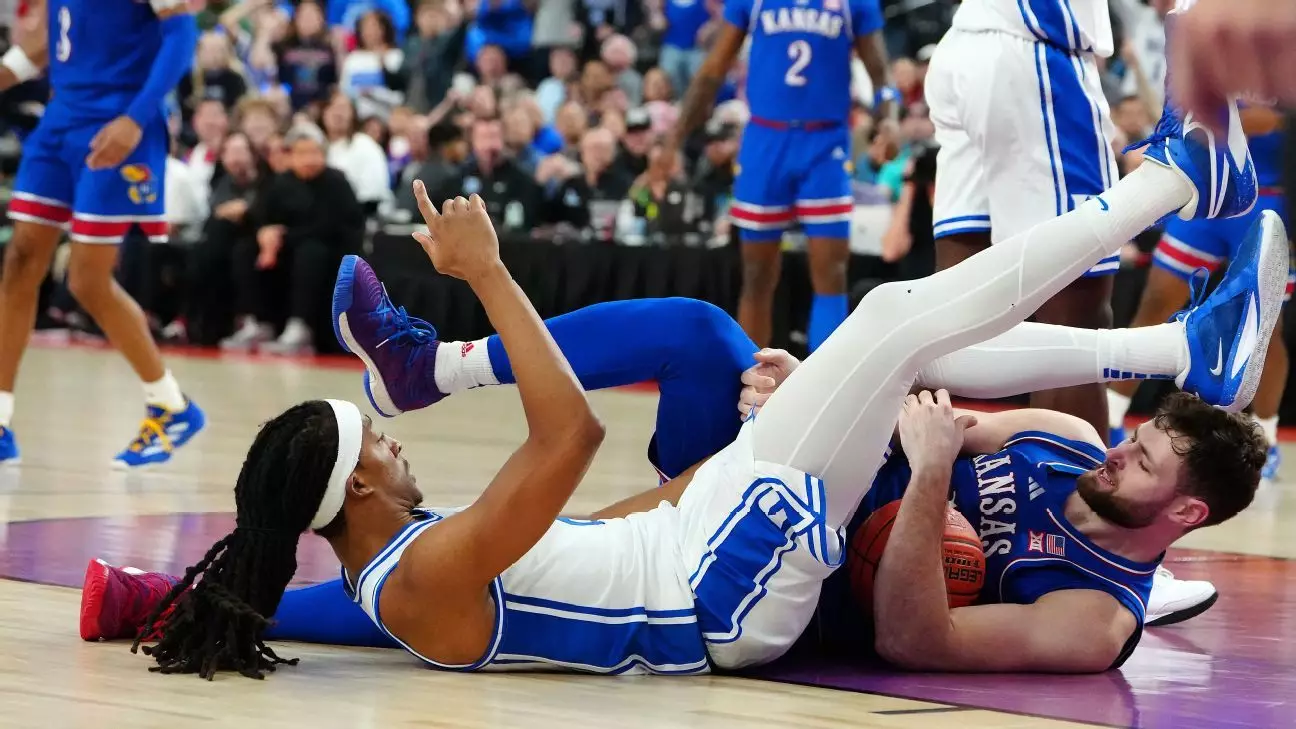The sporting world was shaken this past Tuesday night as the Kansas Jayhawks faced off against Duke in a highly anticipated match. The number-one ranked Jayhawks narrowly escaped with a 75-72 win, yet the spotlight of the game was firmly fixed on a controversial moment that altered its trajectory. Hunter Dickinson, the star center for Kansas, was ejected under contentious circumstances that have since sparked discussions on sportsmanship, decision-making, and the implications of on-court conduct.
The game was marked by intense competition and closely contested play. The event took a pivotal turn when Dickinson, battling for position against Duke forward Maliq Brown, was involved in a physical confrontation that led to his untimely ejection. As he attempted a short jump hook, the two players collided, leading to both of them falling to the floor. In the ruckus, Dickinson kicked his leg out, inadvertently making contact with Brown’s face. The aftermath saw officials gather for what would become a much-debated review of the play.
Following an extensive examination of the incident, officials deemed Dickinson’s actions to be a flagrant foul 2, resulting in an immediate ejection. Despite the urgency of the call, not everyone in attendance available to analyze the play agreed that the heftiness of the flagrant 2 was warranted. Kansas coach Bill Self stated that while he accepted the ruling, he felt the situation might have merited only a flagrant 1. This discrepancy highlights a crucial point of contention in basketball—how differing interpretations of player conduct can significantly influence game outcomes.
Both coaches provided their perspectives that reflected the complicated nature of officiating in high-stakes games. Coach Self acknowledged that while Dickinson made contact with Brown, he believed the level of intentionality might not justify his ejection. Contrarily, Duke’s Jon Scheyer did not hesitate to agree with the officials, emphasizing the need for accountability on the court. Analyzing their comments reveals the dual roles coaches play: defenders of their players while grappling with the integrity of the game itself.
The divide in opinion also showcases a broader challenge in sports: the balance between maintaining game flow and ensuring player safety. The critical question arises—where should the line be drawn? As players are becoming more athletic, the chances of physical encounters escalate, demanding a higher degree of scrutiny in officiating.
The immediate aftermath of Dickinson’s ejection led to a tense standoff between two powerhouse programs. At that juncture, Kansas led by only two points, making every possession crucial. Notably, backup center Flory Bidunga stepped up, contributing to the team’s defense and scoring in the absence of Dickinson. His performance, which included 6 points and 8 rebounds, underscored the depth of the Jayhawks’ roster and hinted at the resilience that is often required in high-pressure situations.
However, the moments leading to the conclusion of the game were fraught with tension. Duke had several opportunities to reclaim the lead, but the pressure led to turnovers and missed shots. This illustrates an essential facet of basketball: momentum shifts can be engendered not just by skillful play but also by psychological factors when players are forced to adapt to sudden in-game changes.
The fallout from the incident offers invaluable lessons, not only for Dickinson but for aspiring athletes viewing the unfolding drama. Mistakes made in the heat of competition can serve as pivotal learning moments that shape future performances. Coach Self noted the potential positive impact of this experience on Dickinson’s development, indicating that even challenging situations could yield growth opportunities.
The ejection of Hunter Dickinson was not merely a pivotal moment in a single game; it sparked vital discussions about officiating standards, the responsibility of players, and the lessons that extend beyond the scoreboard. As Kansas continues to navigate the ramifications of this event, the basketball community watches closely—eagerly anticipating the growth of a player who has already made such a significant impact on the sport.

Leave a Reply